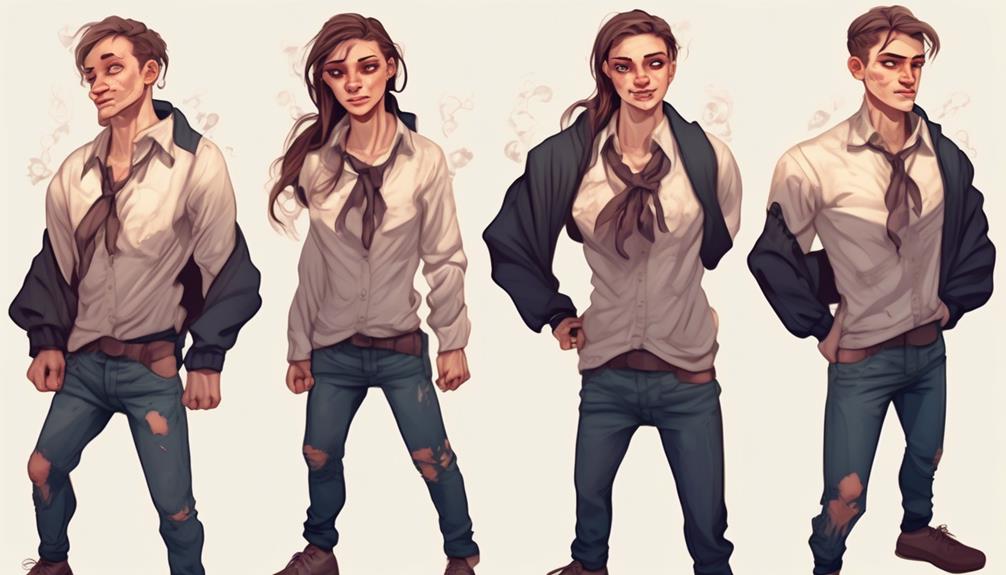As we delve into the complex world of characters in mainstream media, we frequently come across individuals who reflect the intricate aspects of the human mind. These characters, at times displaying characteristics reminiscent of Borderline Personality Disorder, provide insight into the diverse portrayal of mental health.
But what deeper implications lie beneath the surface of these portrayals? How do they shape our perceptions and understanding of BPD, inviting us to explore the blurred lines between fiction and reality in the realm of psychological narratives?
Key Takeaways
- Media portrayal influences mental health stigma perception.
- Characters reflect real BPD complexities for increased understanding.
- Sensitive depictions promote empathy, reduce stigma, and validate experiences.
- BPD-coded characters offer relatability, awareness, and insights into BPD challenges.
Portrayal of BPD in Popular Media
In popular media, the portrayal of Borderline Personality Disorder (BPD) often captures complex character dynamics and emotional intricacies that resonate with audiences. Characters with borderline personality traits like Harley Quinn, Clementine, and Anakin Skywalker exhibit a rollercoaster of emotions, impulsivity, and a deep-seated fear of abandonment, reflecting common characteristics associated with BPD.
These portrayals delve into the raw intensity of their emotions, illustrating the turbulent inner world that individuals with BPD navigate daily. The struggle for identity, the yearning for stable relationships, and the constant battle with self-worth are themes that these characters embody, shedding light on the challenges faced by those with a BPD diagnosis.
Through their narratives, popular media highlights the internal turmoil and external conflicts that individuals with BPD often face, painting a poignant picture of the complexities and nuances of this mental health condition.
Impact on Mental Health Stigma

The portrayal of characters with Borderline Personality Disorder in popular media plays a pivotal role in shaping societal perceptions and attitudes towards individuals with the disorder, potentially influencing the overall mental health stigma. When it comes to characters with BPD, media representation can have a significant impact on mental health stigma:
- Increasing Awareness and Understanding: Accurate portrayal of BPD symptoms in characters can help challenge misconceptions and stereotypes about mental health, fostering a more informed and empathetic society.
- Encouraging Help-Seeking Behavior: Seeing relatable characters in media can encourage individuals with BPD to seek help and support for their condition, promoting early intervention and treatment.
- Perpetuating Harmful Stereotypes: Misrepresentation or romanticization of BPD in characters can perpetuate harmful stereotypes, hindering progress in mental health awareness and perpetuating stigma.
- Influencing Public Perception: Media depictions of characters with BPD can shape public perception and attitudes towards individuals with the disorder, highlighting the importance of responsible and accurate representation.
Nuanced Representation in Characters
Exploring the nuanced portrayals of characters with Borderline Personality Disorder in popular media reveals the complexities of their emotional struggles and interpersonal dynamics. Fictional characters with borderline traits often mirror real-life individuals diagnosed with BPD, showcasing symptoms like emotional intensity, impulsivity, fear of abandonment, and identity struggles. These characters provide a platform to delve into the multifaceted nature of BPD, shedding light on the challenges faced by those with this mental health condition. Here is a table illustrating some of the key characteristics and behaviors exhibited by fictional characters with borderline traits:
| Character | Key Traits |
|---|---|
| Harley Quinn | Emotional intensity, impulsivity |
| Jessica Jones | Trauma, isolation, intense emotions |
| Rebecca Bunch | Impulsiveness, self-loathing |
| Anakin Skywalker | Fear of abandonment, identity struggles |
| Elsa (Frozen) | Isolation, self-protection |
These characters not only entertain but also provide a lens through which to understand and empathize with individuals grappling with BPD.
Importance of Sensitive Depictions

Transitioning from the discussion on nuanced character portrayals, we recognize the critical significance of sensitively depicting individuals with traits of Borderline Personality Disorder in popular media.
- Increasing Awareness and Understanding: Sensitively portraying characters with BPD traits can shed light on the complexities of the disorder, educating the audience and fostering a better understanding of the challenges faced by individuals with BPD.
- Reducing Stigma and Promoting Empathy: Authentic representations in media can help combat the stigma surrounding BPD, encouraging empathy and compassion towards those dealing with the disorder.
- Validation and Support: Accurate depictions provide validation for individuals with BPD, helping them feel seen and understood, ultimately fostering a sense of connection and support within the community.
- Inspiring Conversation and Healing: Thoughtful storytelling can spark important conversations about mental health, encourage individuals to seek help, and promote self-acceptance and healing within both individuals with BPD and society as a whole.
Prevalence of BPD Coded Characters
In media, the prevalence of characters coded with traits of Borderline Personality Disorder serves as a lens through which to examine the complexities of the disorder and its impact on storytelling and audience perception. These characters are often depicted in various forms of media, such as movies, TV shows, and literature, showcasing symptoms like fear of abandonment, impulsive behavior, intense emotions, and struggles with identity. This portrayal not only raises awareness about the challenges faced by individuals with BPD but also allows viewers and readers to connect with the characters on a deeper level due to their relatable struggles and emotional depth.
| Traits of BPD Coded Characters | Impact on Audience |
|---|---|
| Fear of abandonment | Heightened empathy |
| Impulsive behavior | Increased understanding |
| Intense emotions | Emotional resonance |
Analyzing BPD coded characters in media provides valuable insights into the complexities of the disorder and its effects on both individuals and society. By delving into these portrayals, audiences can gain a better understanding of the nuances of Borderline Personality Disorder and foster empathy towards those experiencing it.
Frequently Asked Questions
What Fictional Character Has Borderline Personality Disorder?
When looking at fictional characters, it's important to consider the nuances of mental health representation.
Many complex characters exhibit traits associated with Borderline Personality Disorder, such as emotional intensity and impulsivity. These traits can be seen in characters like Harley Quinn, Anakin Skywalker, Jessica Jones, and others.
It's essential to approach these portrayals with sensitivity and awareness of the impact they may have on individuals with BPD or similar experiences.
What Is BPD Coded?
We're diving into the intricate world of BPD coding, a nuanced depiction of traits associated with Borderline Personality Disorder without an explicit diagnosis. It's like painting with subtle strokes, revealing characteristics such as fear of abandonment and intense emotions.
This technique shines a spotlight on mental health struggles, fostering understanding and empathy. While not a replacement for accurate depiction, BPD coding in characters acts as a catalyst for crucial conversations on emotional regulation and mental health awareness.
Why Is BPD Life Expectancy 27?
We don't have a reduced life expectancy compared to the general population. The misconception about BPD life expectancy at 27 may come from misunderstandings or stigma about the disorder.
It's crucial to debunk such myths and provide accurate information to reduce stigma. Seeking reliable sources and consulting mental health professionals can help clarify misconceptions about BPD and life expectancy.
It's essential to promote understanding and combat misinformation about BPD.
What Are the 4 Subtypes of Bpd?
Sure thing!
The 4 subtypes of BPD are Discouraged Borderline, Impulsive Borderline, Petulant Borderline, and Self-Destructive Borderline. Each subtype presents unique challenges and characteristics.
Discouraged Borderline deals with emptiness and low self-esteem. Impulsive Borderline shows impulsive behaviors like substance abuse. Petulant Borderline depicts passive-aggressive tendencies. Self-Destructive Borderline involves self-harming behaviors and suicidal thoughts.
Understanding these distinctions is crucial for effective treatment and support.
Conclusion
In conclusion, BPD coded characters in popular media play a crucial role in highlighting the complexities of Borderline Personality Disorder.
It's interesting to note that a study found that 1.6% of the general population may have BPD, emphasizing the importance of accurate and sensitive representations in media.
By portraying the struggles and challenges faced by individuals with BPD, these characters help increase awareness and understanding of the disorder, ultimately contributing to reducing stigma and promoting empathy.









